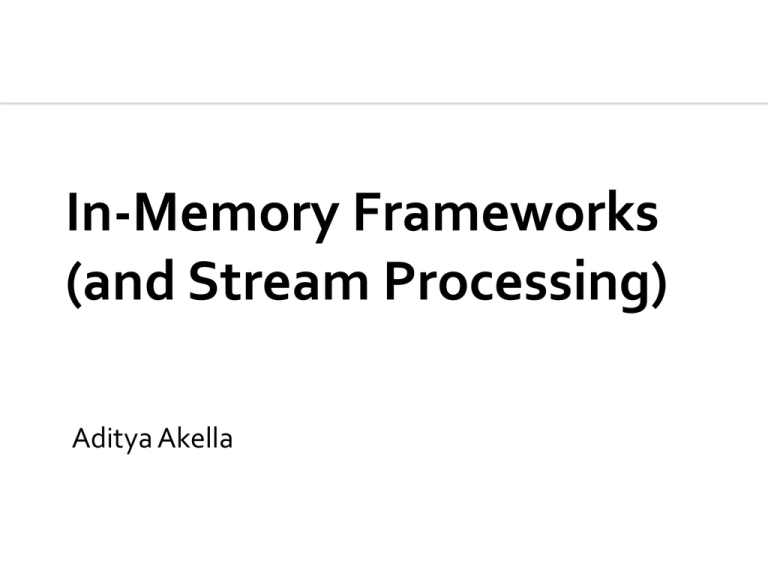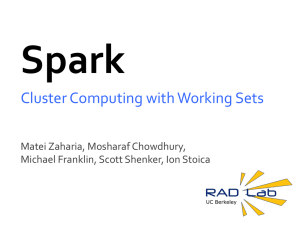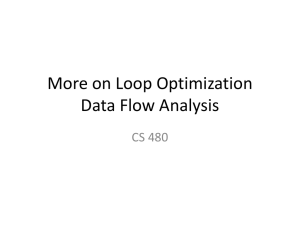Slides
advertisement

In-Memory Frameworks
(and Stream Processing)
Aditya Akella
Piccolo (OSDI 2010)
Building Fast, Distributed Programs with Partitioned
Tables
Resilient Distributed Datasets (NSDI 2012)
A Fault-Tolerant Abstraction for
In-Memory Cluster Computing
Discretized Streams (HotCloud 2012)
An Efficient and Fault-Tolerant Model for Stream
Processing on Large Clusters
Motivation
MapReduce greatly simplified “big data” analysis
on large, unreliable clusters
But as soon as it got popular, users wanted more:
»More complex, multi-stage applications
(e.g. iterative machine learning & graph processing)
»More interactive ad-hoc queries
Response: specialized frameworks for some of
these apps (e.g. Pregel for graph processing)
Motivation
Complex apps and interactive queries both need
one thing that MapReduce lacks:
Efficient primitives for data sharing
In MapReduce, the only way to share data
across jobs is stable storage slow!
Examples
HDFS
read
HDFS
write
HDFS
read
iter. 1
HDFS
write
. . .
iter. 2
Input
HDFS
read
Input
query 1
result 1
query 2
result 2
query 3
result 3
. . .
Slow due to replication and disk I/O,
but necessary for fault tolerance
Goal: In-Memory Data Sharing
iter. 1
iter. 2
. . .
Input
query 1
one-time
processing
Input
query 2
query 3
. . .
10-100× faster than network/disk, but how to get FT?
Challenge
How to design a distributed memory abstraction
that is both fault-tolerant and efficient?
Approach 1: Fine-grained
E.g., Piccolo (Others: RAMCloud; DSM)
Distributed Shared Table
Implemented as an in-memory (dist) key-value
store
Kernel Functions
Operate on in-memory state concurrently on
many machines
Sequential code that reads from and writes to
distributed table
Using the store
get(key)
put(key,value)
update(key,value)
flush()
get_iterator(partition)
User specified policies
… For partitioning
Helps programmers express data locality
preferences
Piccolo ensures all entries in a partition reside
on the same machine
E.g., user can locate kernel with partition,
and/or co-locate partitions of different related
tables
User-specified policies
… for resolving conflicts (multiple kernels
writing)
User defines an accumulation function (works if
results independent of update order)
… for checkpointing and restore
Piccolo stores global state snapshot; relies on
user to check-point kernel execution state
Fine-Grained: Challenge
Existing storage abstractions have interfaces
based on fine-grained updates to mutable state
Requires replicating data or logs across nodes
for fault tolerance
» Costly for data-intensive apps
» 10-100x slower than memory write
Coarse Grained: Resilient
Distributed Datasets (RDDs)
Restricted form of distributed shared memory
» Immutable, partitioned collections of records
» Can only be built through coarse-grained
deterministic transformations (map, filter, join, …)
Efficient fault recovery using lineage
» Log one operation to apply to many elements
» Recompute lost partitions on failure
» No cost if nothing fails
RDD Recovery
iter. 1
iter. 2
Input
query 1
one-time
processing
Input
query 2
query 3
. . .
. . .
Generality of RDDs
Despite their restrictions, RDDs can express
surprisingly many parallel algorithms
» These naturally apply the same operation to many items
Unify many current programming models
» Data flow models: MapReduce, Dryad, SQL, …
» Specialized models for iterative apps: BSP (Pregel),
iterative MapReduce (Haloop), bulk incremental, …
Support new apps that these models don’t
Tradeoff Space
Network
bandwidth
Fine
Granularity
of Updates
Memory
bandwidth
Best for
transactional
workloads
K-V
stores,
databases,
RAMCloud
Best for batch
workloads
HDFS
RDDs
Coarse
Low
Write Throughput
High
Spark Programming Interface
DryadLINQ-like API in the Scala language
Usable interactively from Scala interpreter
Provides:
» Resilient distributed datasets (RDDs)
» Operations on RDDs: transformations (build new RDDs),
actions (compute and output results)
» Control of each RDD’s partitioning (layout across nodes)
and persistence (storage in RAM, on disk, etc)
Spark Operations
Transformations
(define a new RDD)
Actions
(return a result to
driver program)
map
filter
sample
groupByKey
reduceByKey
sortByKey
flatMap
union
join
cogroup
cross
mapValues
collect
reduce
count
save
lookupKey
Task Scheduler
Dryad-like DAGs
Pipelines functions
within a stage
Locality & data
reuse aware
Partitioning-aware
to avoid shuffles
B:
A:
G:
Stage 1
C:
groupBy
D:
F:
map
E:
Stage 2
join
union
= cached data partition
Stage 3
Example: Log Mining
Load error messages from a log into memory, then
interactively search for various patterns
lines = spark.textFile(“hdfs://...”)
BaseTransformed
RDD
RDD
results
errors = lines.filter(_.startsWith(“ERROR”))
messages = errors.map(_.split(‘\t’)(2))
messages.persist()
tasks
Master
Msgs. 1
Worker
Block 1
Action
messages.filter(_.contains(“foo”)).count
Msgs. 2
messages.filter(_.contains(“bar”)).count
Worker
Msgs. 3
Result: scaled
full-text
tosearch
1 TB data
of Wikipedia
in 5-7 sec
in <1(vs
sec170
(vssec
20 for
secon-disk
for on-disk
data)data)
Worker
Block 3
Block 2
Fault Recovery
RDDs track the graph of transformations that
built them (their lineage) to rebuild lost data
E.g.:
messages = textFile(...).filter(_.contains(“error”))
.map(_.split(‘\t’)(2))
HadoopRDD
HadoopRDD
FilteredRDD
FilteredRDD
path = hdfs://…
func = _.contains(...)
MappedRDD
MappedRDD
func = _.split(…)
Iteratrion time (s)
Fault Recovery Results
140
120
100
80
60
40
20
0
Failure happens
119
81
1
57
56
58
58
57
59
57
59
2
3
4
5
6
Iteration
7
8
9
10
Example: PageRank
1. Start each page with a rank of 1
2. On each iteration, update each page’s rank to
Σi∈neighbors ranki / |neighborsi|
links = // RDD of (url, neighbors) pairs
ranks = // RDD of (url, rank) pairs
Example: PageRank
1. Start each page with a rank of 1
2. On each iteration, update each page’s rank to
Σi∈neighbors ranki / |neighborsi|
links = // RDD of (url, neighbors) pairs
ranks = // RDD of (url, rank) pairs
for (i <- 1 to ITERATIONS) {
ranks = links.join(ranks).flatMap {
(url, (links, rank)) =>
links.map(dest => (dest, rank/links.size))
}.reduceByKey(_ + _)
}
Optimizing Placement
Links
Ranks0
(url, neighbors)
(url, rank)
join
Contribs0
reduce
Ranks1
join
Contribs2
reduce
Ranks2
. . .
links
& ranks repeatedly joined
Can co-partition them (e.g. hash
both on URL) to avoid shuffles
Can also use app knowledge,
e.g., hash on DNS name
links = links.partitionBy(
new URLPartitioner())
Time per iteration (s)
PageRank Performance
200
171
Hadoop
150
100
50
0
Basic Spark
72
23
Spark + Controlled
Partitioning
Programming Models
Implemented on Spark
RDDs can express many existing parallel models
» MapReduce, DryadLINQ
» Pregel graph processing [200 LOC]
» Iterative MapReduce [200 LOC]
» SQL: Hive on Spark (Shark) [in progress]
All are based on
coarse-grained
operations
Enables apps to efficiently intermix these models
Spark: Summary
RDDs offer a simple and efficient programming
model for a broad range of applications
Leverage the coarse-grained nature of many
parallel algorithms for low-overhead recovery
Issues?
Discretized Streams
Putting in-memory frameworks to work…
Motivation
• Many important applications need to process
large data streams arriving in real time
– User activity statistics (e.g. Facebook’s Puma)
– Spam detection
– Traffic estimation
– Network intrusion detection
• Target: large-scale apps that must run on tenshundreds of nodes with O(1 sec) latency
Challenge
• To run at large scale, system has to be both:
– Fault-tolerant: recover quickly from failures and
stragglers
– Cost-efficient: do not require significant hardware
beyond that needed for basic processing
• Existing streaming systems don’t have both
properties
Traditional Streaming Systems
• “Record-at-a-time” processing model
– Each node has mutable state
– For each record, update state & send new records
mutable state
input records
node 1
push
node 3
input records
node 2
Traditional Streaming Systems
Fault tolerance via replication or upstream
backup:
input
input
node 1
node 3
input
node 2
node 1’
node 2
standby
node 3’
node 2’
node 3
input
synchronization
node 1
Traditional Streaming Systems
Fault tolerance via replication or upstream
backup:
input
input
node 1
node 3
input
node 2
node 3
input
synchronization
node 1’
node 1
node 2
standby
node 3’
Fastnode
recovery,
but 2x
2’
hardware cost
Only need 1 standby,
but slow to recover
Traditional Streaming Systems
Fault tolerance via replication or upstream
backup:
input
input
node 1
node 3
input
node 2
node 3
input
synchronization
node 1
node 2
node 1’
standby
node 3’
node 2’
Neither approach tolerates stragglers
Observation
• Batch processing models for clusters (e.g.
MapReduce) provide fault tolerance efficiently
– Divide job into deterministic tasks
– Rerun failed/slow tasks in parallel on other nodes
• Idea: run a streaming computation as a series
of very small, deterministic batches
– Same recovery schemes at much smaller timescale
– Work to make batch size as small as possible
Discretized Stream Processing
t = 1:
batch operation
input
pull
immutable dataset
(output or state);
stored in memory
without replication
immutable dataset
(stored reliably)
…
input
…
…
t = 2:
stream 1
stream 2
Parallel Recovery
• Checkpoint state datasets periodically
• If a node fails/straggles, recompute its dataset
partitions in parallel on other nodes
map
input dataset
output dataset
Faster recovery than upstream backup,
without the cost of replication
Programming Model
• A discretized stream (D-stream) is a sequence
of immutable, partitioned datasets
– Specifically, resilient distributed datasets (RDDs),
the storage abstraction in Spark
• Deterministic transformations operators produce
new streams
D-Streams Summary
• D-Streams forgo traditional streaming wisdom
by batching data in small timesteps
• Enable efficient, new parallel recovery scheme
Related Work
• Bulk incremental processing (CBP, Comet)
– Periodic (~5 min) batch jobs on Hadoop/Dryad
– On-disk, replicated FS for storage instead of RDDs
• Hadoop Online
– Does not recover stateful ops or allow multi-stage jobs
• Streaming databases
– Record-at-a-time processing, generally replication for FT
• Parallel recovery (MapReduce, GFS, RAMCloud, etc)
– Hwang et al [ICDE’07] have a parallel recovery protocol for
streams, but only allow 1 failure & do not handle stragglers
Timing Considerations
• D-streams group input into intervals based on
when records arrive at the system
• For apps that need to group by an “external”
time and tolerate network delays, support:
– Slack time: delay starting a batch for a short fixed
time to give records a chance to arrive
– Application-level correction: e.g. give a result for
time t at time t+1, then use later records to update
incrementally at time t+5
D-Streams vs. Traditional Streaming
Concern
Discretized Streams
Record-at-a-time Systems
Latency
0.5–2s
1-100 ms
Consistency
Yes, batch-level
Not in msg. passing systems;
some DBs use waiting
Failures
Parallel recovery
Replication or upstream bkp.
Stragglers
Speculation
Typically not handled
Unification
with batch
Ad-hoc queries from
Spark shell, join w. RDD
Not in msg. passing systems;
in some DBs







